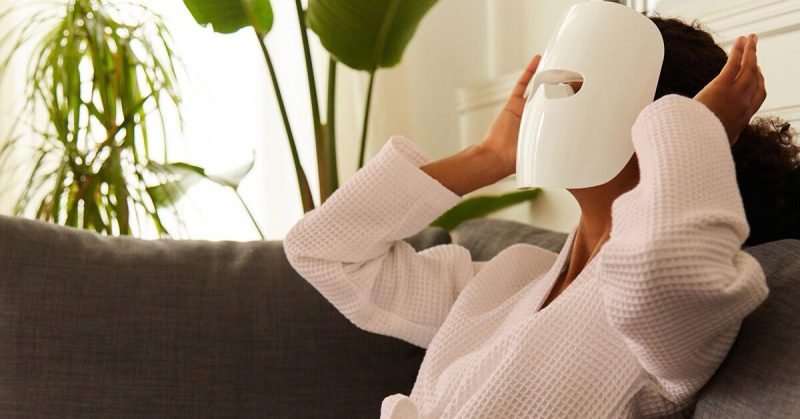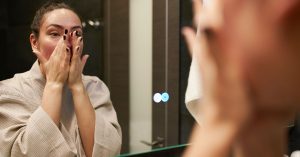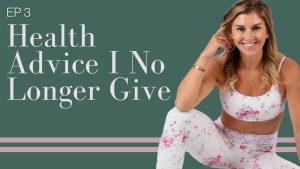Types, Devices, and What to Expect

We include products we think are useful for our readers. If you
buy through links on this page, we may earn a small commission. Here’s our process.
How we vet brands and products
Greatist only shows you brands and products that we stand behind.
Our team thoroughly researches and evaluates the recommendations we make on our site. To establish that the product manufacturers addressed safety and efficacy standards, we:
- Evaluate ingredients and composition: Do they have the potential to cause harm?
- Fact-check all health claims: Do they align with the current body of scientific evidence?
- Assess the brand: Does it operate with integrity and adhere to industry best practices?
We do the research so you can find trusted products for your health and wellness.
Some forms of light therapy can kill the bacteria that cause acne. At-home red and blue lights tend to work best on basic pimples. But for more severe acne, professional photopneumatic therapy might work best.
If you’re one of the many facing adult acne, you may have tried all types of creams, ointments, and medications to smooth your skin. But what about light therapy? Many folks treat acne with lasers and lights, even at home!
But does light therapy live up to the hype? Here’s a look at whether this easy treatment works.
Acne forms when bacteria, dirt, oil, or dead skin cells get trapped in your pores, plugging them up. Your body responds by creating inflammation, swelling the skin into the bumps we know as pimples.
So… what does a beam of light have to do with plugged pores?
Certain types of light can kill the bacteria on your skin, allowing it to heal more quickly. And bonus: Light therapy can even help shrink your skin’s oil glands, prompting your body to create less of the oil that clogs them in the first place.
Light therapy could also be a godsend for folks with lingering scars from previous breakouts. Red light devices, in particular, may accelerate the skin’s healing process by prompting collagen production.
You can find a variety of at-home light therapy devices online, such as on Amazon or boutique sellers like Optum. Or look at nationwide retailers like Sephora or Ulta Beauty. (Heck, even Wal-Mart sells several.)
If you’d prefer to receive treatment from a pro, ask your dermatologist if they provide in-office light therapy. If they don’t, request a referral for a legit practitioner who does. Picking your derm’s brain for recs is a better bet than googling, trust us.
Any time you decide to put money and time into a medical treatment, you probs want to find out whether it’s got evidence to back it up. The question on everyone’s mind: Does acne light therapy, you know, work?
“There has been some clinical evidence like this study from The Journal of Clinical and Aesthetic Dermatology that showed that daily self-treatment using the device for mild-to-moderate inflammatory acne reduced the number of acne lesions significantly,” says Dr. Jeannette Graf, MD, board-certified dermatologist and assistant clinical professor of dermatology at Mt. Sinai School of Medicine.
Still, that doesn’t mean an at-home light show is a miracle treatment for acne.
“There hasn’t been strong evidence that light therapy is any more effective than other acne treatment options, like topical retinoids,” Dr. Graf says.
But, according to the American Academy of Dermatology (AAD), people may see at least some skin clearing from laser therapies. Results vary from person to person, and you may need multiple treatments over months or years to experience desired outcomes.
The various types of at-home light therapy for acne are grouped by color. You’ve got your choice of blue, red, or red-and-blue light, each of which uses visible light to treat pimples.
Red light offers the advantage of stimulating collagen production to reduce the appearance of acne scars. It also reaches into deep layers of the skin, reducing inflammation beneath the surface. Optum’s TheraFace Pro, for example, features a red light setting to penetrate deep beneath the skin of the face.
Blue light, on the other hand, mainly reaches the epidermis (the top layer of skin), killing bacteria that cause breakouts. Check out Optum’s reVive Light Therapy LUX Essentials Light Therapy Device for a blue light device under $100.
A red-and-blue combo, meanwhile, pairs the acne-busting benefits of red and blue light in a single device. Optum’s reVive Light Therapy Glō Anti-Acne Device features both colors for just $79.
In-office light therapies may differ from the ones you can do at home. If you try this treatment in a clinical setting, you might receive photodynamic therapy (PDT). In PDT, your practitioner applies a solution that makes your skin more light-sensitive. After this solution soaks in for 15 minutes to 3 hours, your provider will use a laser or light device to treat affected areas.
Stubborn zits? Another in-office option is photopneumatic therapy. In this treatment, an intense pulsed light and a gentle vacuum work together to remove excess oil and dead skin from clogged pores.
Which light therapy is best for acne?
Depending on your acne type, one version of light therapy may be better for kicking zits to the curb.
According to the AAD, the red, blue, and combo lights used in at-home devices are only effective on basic pimples, not blackheads, whiteheads, cystic acne, or nodules. But you may need to head to the derm for PDT or photopneumatic therapy for more severe acne versions.
Then again, for a bit of glow-up to banish run-of-the-mill pimples, at-home treatments with blue light may be all you need.
“Blue light is the most effective type of light therapy for acne because it can eliminate the bacteria that are responsible for producing acne,” says Dr. Graf.
Wands, guns, masks, shields — holy beauty regimen, Batman, there are a lot of light devices for acne. Each one comes with its operating instructions, so be sure to read directions thoroughly before lighting up.
Masks, for example, sit on the face for around 10-25 minutes per session, so find a place to get comfy for a while. Light wands, on the other hand, typically require less time. Most take just 3–5 minutes per treatment. Aim the wand at your face or other acne-prone areas and move in circular motions.
Or consider a free-standing light “shield.” This device sits over your face (without touching it) as you lie on your back for about 30 minutes. Grab your headphones and chill out while it blasts away bacteria.
Whichever device you choose, Graf says consistency is the name of the game for best results.
“Using light therapy every few weeks won’t show an improvement in your skin,” she says. “To see significant change, using it three to five times a week is usually ideal.”
For those who struggle with persistent acne, light therapy may be worth a try — both to zap bacteria on the surface of the skin and quell inflammation at a deeper level.
Remember that masks, wands, and other light-up doodads are just one piece of the acne-fighting puzzle. A solid overall skincare regimen is still necessary.
“Pairing light therapy with other acne treatments can certainly be more effective than using it on its own,” says Graf. “The inclusion of a good skincare routine coupled with light therapy is how you will see the best results.”








